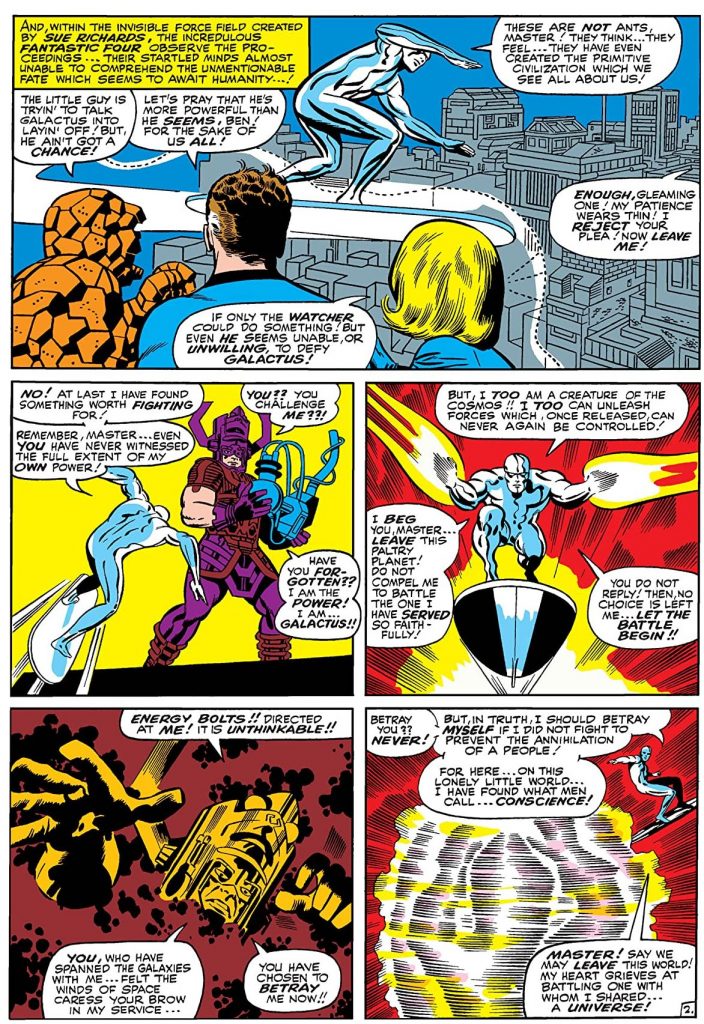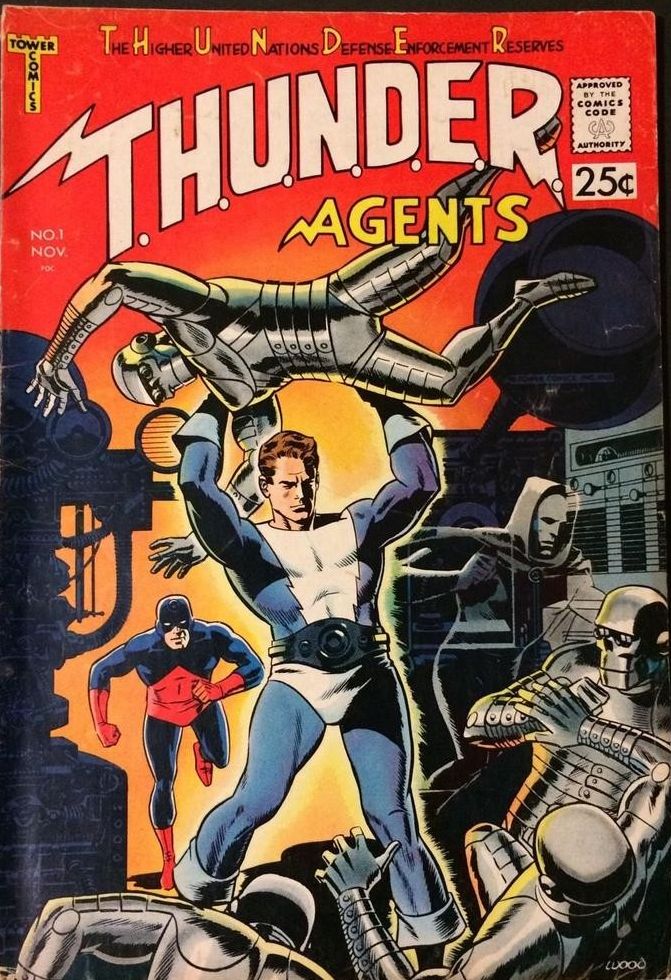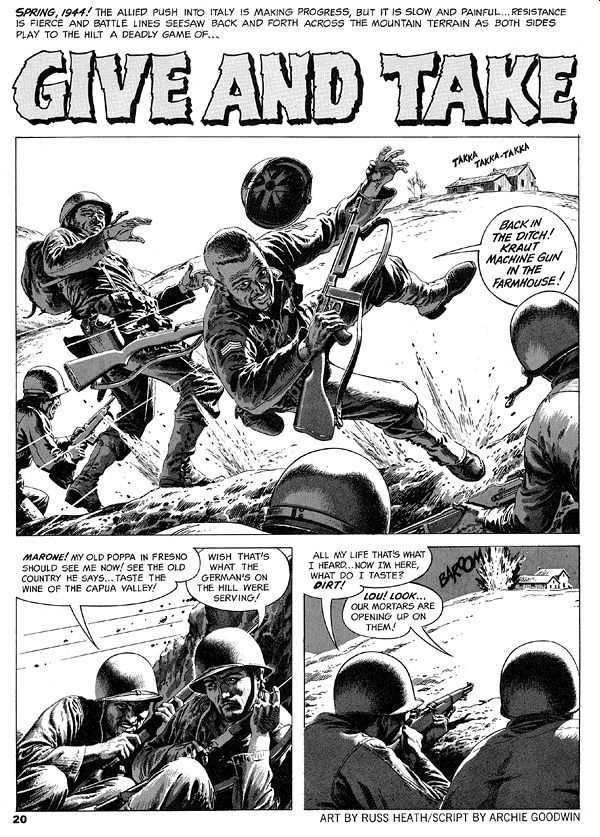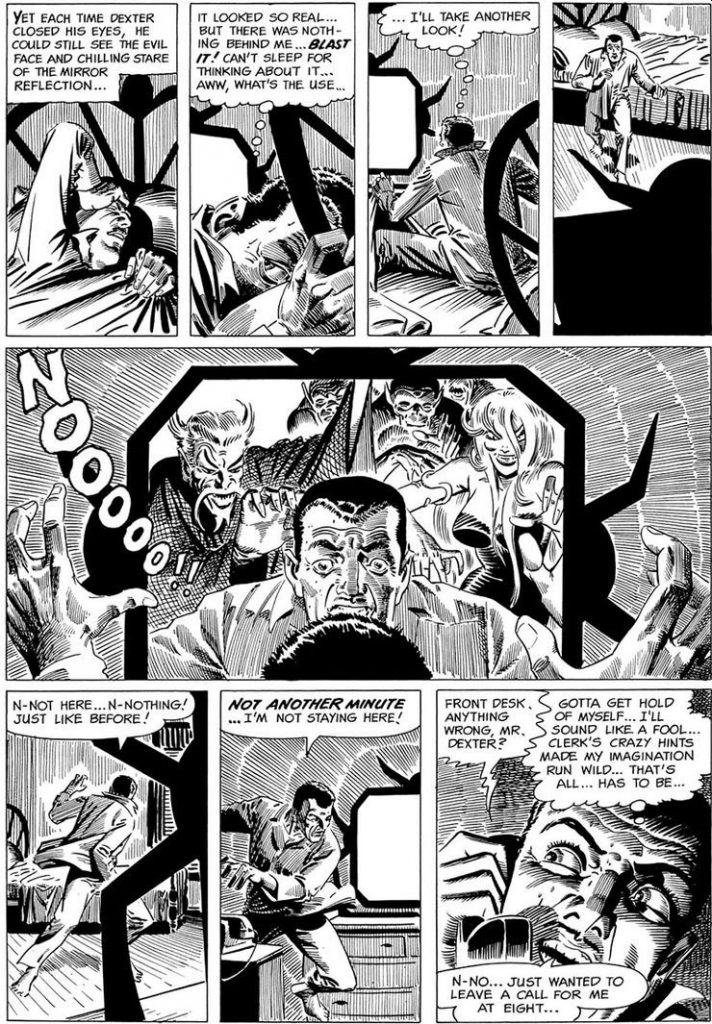
by Jason Sacks
Is 1966 the best year ever for comic books? Yeah… maybe!
Based on the articles I’ve been seeing in newspapers, magazines and fanzines, Batman appears to be the runaway hit tv program of 1966. After 12 episodes, this show has exceeded expectations for fans and non-fans alike. Who would have expected Batman to be so true to the comics, with appearances by the Joker, Mr. Freeze, the Mad Hatter and even an obscure character like the Riddler (who hadn’t appeared in any comics between 1948 and 1965!).
The show has been a delight, and has prompted this house to buy a brand new color TV to enjoy it in its full splendor (well, that, and we had to see the exotic locations in Man from U.N.C.L.E. in color, too). And gosh, what a tremendous show this is for its bright and shiny design elements. The costumes of Batman, the Joker and Robin all look spectacular on our new Admiral set!

I know there has been some grousing about how the show mocks the Caped Crusader and his faithful pal, but I frankly love it. Maybe I’ve been desperate for a superhero TV show since Superman left the air a decade ago, but I dig the clever ways the show’s producers incorporate comic book elements into every scene of the show. The “BIFF! BANG! POW” elements during fight scenes may annoy some viewers who want more seriousness in their superheroes, but to me these are like comic book panels writ large on my 25” screen, thrilling reminders of their roots while also giving TV viewers a clever motif to groove on. Others complain that the characters seem self-mocking, calling it “camp” (a phrase I’ve never heard in this context before), but I wonder if those complainers read the Batman comics I wrote about last year. Until very recently, Batman was a moribund character fated for cancelation, so I’m delighted to see him get any attention at all.
And I groove on the deathtraps these characters find themselves in every Wednesday prior to the Thursday conclusions. Ma Bell likes it too, I think, because my friends and I call each other every week to try to figure out how our heroes can escape from the amazing perils the villains place them in.

I’m starting to see a rise in the interest in super-heroes at my local newsstand, perhaps prompted by the success of the TV show. It also helps that so many of the comics being released today are absolutely great. Not only are Marvel and National releasing lines of comics that are more intriguing than they have ever been, but new and revived publishers are putting out some comics that are outstanding (and some that are less than great, but hey, that’s just the law of averages at play, I think).
A lot of the thrill these days has been at Marvel, as some of their comics are reaching unparalleled new levels of excellence. For instance, the work of Steve Ditko and Stan Lee on both Amazing Spider-Man and the “Dr. Strange” strip in Strange Tales has been outstanding. Peter Parker has graduated high school and enrolled at Empire State University in Spider-Man. Pete seems to be shedding his nature as a nebbish since he joined college, making new friends while having new (and more sophisticated) problems. The three-part “Master Planner” saga which ended in ASM #33 was a storyline nonpareil, a thrill a minute journey with a spectacular denouement. (I’m including the payoff below, but please try to find all these issues if you can, because the leadup is just as spectacular).

Ditko and Lee’s “Doctor Strange” is in the midst of an astonishing long saga which journeys to strange, mystical realms to bring readers scenes we’ve never seen before. This lone hero fights impossible obstacles, issue by painful issue, to save a humanity who have no idea of his heroics. These two Ditko-illustrated comics are breathtaking – and, as I’ll soon discuss, this prolific artist is working on more than two comics lately.
Those two series are two of the three best comics being released in 1966, but the third greatest comic of our year has to be Fantastic Four. Stan Lee and the incomparable Jack Kirby (King of the Comics) are delivering the most astonishing thrill-ride in comics history. Reed Richards married Sue Storm in the 1965 FF Annual, but the couple's life has been no honeymoon since their big event, as they’ve fought an incredible “Battle for the Baxter Building”, before meeting and fighting the astonishing Inhumans. But this month has produced perhaps the finest comic Marvel has ever printed. In this month’s FF #50, the heroes found themselves in conflict with the mysterious cosmic villain Galactus, who wants to eat the Earth simply to stay alive. Readers are swept away with the desperation of our heroes and their valiant battle to save our planet, a story only Jack Kirby could have drawn. It also features the character I believe will be the breakout hero of 1966, the star-spanning Silver Surfer.

Marvel’s also producing some other great comics. Thor has moved out of the old Journey Into Mystery anthology into his own comics title, and Lee and Kirby are delivering a godlike battle there which shakes the cosmos. In X-Men, Lee and artist Jay Gavin keep playing and have delivered an intriguing new hero-villain called the Mimic. Lee and new artist John Romita have been doing terrific work on Daredevil (Romita might be a good substitute for Ditko if the latter ever has to take a month off; it’s hard to imagine Ditko leaving the character permanently). And comics like Avengers, Sgt. Fury, Two-Gun Kid and Tales to Astonish are continuing to deliver satisfying action stories, with the shattered romance tale "Killed in Action" in Fury #18 a real standout.
At National, which some people call DC, the line has adopted a new set of “go-go checks” at the top of their covers. Besides being hep and fun, these checks also help the comics stand out at my local drug store rack – a smart decision if you ask me.

Inside their comics, National continues their solid comics storytelling. Editor Julius Schwartz’s line is consistently entertaining. The Atom, Batman, Detective Comics, Hawkman and Green Lantern are all standouts for both story and art. Meanwhile, action heroes like the Metal Men, the Challengers of the Unknown and the Sea Devils all continue to deliver fun excitement, and Doom Patrol is always an irreverent treat. New series Teen Titans promises to be fun, and what teen or pre-teen wouldn't groove to the tales of sidekicks joined together?
I was disappointed to see Adam Strange, Space Ranger and Rip Hunter… Time Master lose their ongoing strips, though I'm anxious to see what replaces them. And though Wonder Woman seems to continue to wander in its own mediocre wilderness (now set in the passé 1940s), the National line seems to be consistently entertaining each month. Of course, it’s hard to project how the massive success of Batman on TV will affect the comics, but one hopes the publisher won’t adopt those “camp” elements fans are so mixed about.
But some of the most exciting news in comics is happening outside of these two dominant publishers.
Gold Key Comics, primarily known for their comics featuring adaptations of TV series as diverse as Top Cat, Flipper and My Favorite Martian as well as their Disney line, is continuing their adventure comics line and even expanding the line. In fact, Super Goof set Mickey's pal Goofy as a super-hero in a delightful series of adventures as Super Goof!

Gold Key is the former sister publisher to Dell Comics, and it can often be hard to tell the two companies apart from each other despite their differences in editioral staffs. Their line also mainly consists of adapted titles like The Beverly Hillbillies and The Outer Limits along with a handful of original titles like Ghost Stories and Air War Stories. That line included a few new originals, including the gross-out Melvin Monster (which seems to be done by the same staff who deliver the delightful Thirteen Going on Thirty series) and the super-hero Nukla. I was also surprised to see a Black cowboy comic on the stands from Dell. Lobo is the stor of a buffalo soldier accused of a crime he didn't commit, and the first issue is pretty terrific! This may be the first comic featuring a solo Black character in his own title in many years (I believe there were a couple published by small companies in the 1940s), which is a nice sign of progress for the Great Society.

For many years, Charlton Comics have been considered at the bottom of the barrel, with their comics consistently delivering hackneyed and dull stories. Making things worse, Charltons seem like they’re printed on a cereal box press, with a strange paper texture, jagged edges on some of their pages, and even an odd smell to some of their comics.

Thankfully, though their printing quality doesn’t seem to be improving, Charlton’s comics are indeed improving. New series Peter Cannon… Thunderbolt launched early this year and has been fun. With art (and story?) by the mysterious PAM, these stories combine a surprising Eastern influence with New York gangsters. This is a series to watch.
Even more exciting is Captain Atom. You may remember the good Captain as an early sci-fi superhero from 1959 and 1960. Forget what you read before. The great Steve Ditko is now drawing Captain Atom’s adventures, and, let me tell you, they are as good as the stories Ditko is drawing at Marvel. Ditko’s Captain Atom is dynamic, fun and gorgeously illustrated. You’ll get bragging rights among your friends for recommending these comics to them.

I wish I could recommend Archie Comics’ line of superheroes to you, but they are painful to read. For many years now Archie has been publishing The Fly, but now the character has been renamed Fly Man in his own series (maybe to confuse Spider-Man fans?) and is also part of a new super-team called The Mighty Crusaders. That new team comic might be the worst comic of 1966, even worse than Wonder Woman.
The Archie heroes are written and drawn in a painful pastiche of the Marvel style, with “hip” dialogue and “fun” captions that read like a grandfather desperately trying to connect with his goatee-wearing grandkids. These comics aren’t just groan-inducing, they’re downright painful. Ignore them.
On a happier note, new publisher Tower Comics has been a very pleasant surprise. Their flagship title is THUNDER Agents, a fun mix of super-heroes and spy agencies that sets super-heroes No-Man, Dynamo, Menthor and Lightning against the evil Warlord.

So far, each issue has been double-sized, which means it’s packed with great and dynamic stories. Best of all, it includes illustrations from some of my beloved masters of comic book art, including Wally Wood, Reed Crandall, Gil Kane, George Tuska, Mike Sekowsky and others. These have been terrific comics, well worth seeking out. According to the fanzines, Tower has been doing well and should be available most everywhere, but if not, remind your local newsstand owner that he should make higher profits at 25¢ retail per issue.
Superheroes continue at American Comics Group as well. ACG comics always seem to range from “ok” to “weird as can be.” In the former category are Nemesis in Adventures into the Unknown and Magicman in Forbidden Worlds. Both those series read like mediocre Marvel or National comics, which is just fine.

But if you’re not picking up an occasional issue of Herbie, you’re missing one of the strangest, most inexplicable comics on the stands today. Just look at that cover above if you don’t believe me. I don’t even want to try to describe this unprecedented series to you because it’s just so surreal and delightful. I laugh more at this comic than I ever will at a year's worth of Archie hero comics. I promise you that Herbie and his lollipop will burrow into your brain.
The most unexpected premier of the last year has been the appearance of Captain Marvel on the newsstands, but it's not the Captain Marvel you'd think of. Newcomer publisher M.F. Publications has launched the adventures of a completely new Captain Marvel. Instead of shouting "Shazam", this Cap screams "split" and splits off his hands, legs and head so he can fight multiple criminals at the same time. Yes, it's all as odd as it sounds, made even odder by the fact that apparently the series is written and drawn by Carl Burgos, the man who created the original Human Torch back in the early 1940s!

The last stop in our journey through comics in 1966 takes us to the magazine rack. On the cheaper area of some racks we might find magazine-sized comics from M.F., including their wretched seridss Weird. The less said about the terrible stories and art in Weird the better. Thankfully next to Weird,where we will find Warren Magazines. You might remember Warren from my article about the late, lamented Help! Magazine, which sadly recently saw its final issue on the newsstand. Thankfully publisher James Warren has filled that gap with two great horror comics and an even better war comic.

Warren started publishing horror anthology Creepy in late 1964, and that mag has built a deserved reputation as one of the finest horror comics ever published, a worthy successor to the classic EC Comics. In fact, that comparison is appropriate because Creepy and its new sister title Eerie have published great horror tales drawn by the likes of Al Williamson, John Severin, Reed Crandall and Johnny Craig – EC legends all. Even more thrilling, those brilliant artists have been joined by modern counterparts like Gene Colan, the astonishing Alex Toth and, yes, the brilliant Steve Ditko. I told you Ditko gets around! With brilliant writing by the always adept Archie Goodwin, these comics are a tremendous treat.

I’m also a huge fan of Warren’s war comic Blazing Combat. Also written by Goodwin, the three issues thus far include brilliant artwork accompanying piercing and terrifying war tales that tell the gritty truth of war as it really is. They are the second best war comics ever published, behind only the truly great war comics written and edited by Harvey Kurtzman at EC. I’m sure BC doesn’t sell well, so I beg all comics readers to pick up this magazine while they still can. It costs three times as much as a standard comic, at 35¢ per issue, so I understand peoples' reluctance at picking up issues of this amazing series.
Whew! You can see why I say comics may never have been better than they are today. Truly, any trip to the comics rack will bring you some delightful treasures no matter what sorts of comics you like.
One final note: here in my native Brooklyn, there seemed to be some strange event over Mt. Sinai Hospital today. We saw some storks on the roof of the hospital. Anybody with any information on the events at the hospital that day, please contact this magazine.

The Journey is once again up for a Best Fanzine Hugo nomination — and its founder is up for several other awards as well! If you've got a Worldcon membership, or if you just want to see what Gideon's done that's Hugo-worthy, please read his Hugo Eligibility article! Thank you for your continued support.

![[February 24, 1966] Is 1966 the Best Year Ever for American Comic Books?](https://galacticjourney.org/wp-content/uploads/2021/02/thunder-671x372.jpg)

![[February 22, 1966] A New Age? <i>Impulse</i> and <i>New Worlds</i>, March 1966](https://galacticjourney.org/wp-content/uploads/2021/02/Impulse-NW-March-1966-672x372.png)











![[February 20, 1966] An Embarrassment of Riches (February Galactoscope #2)](https://galacticjourney.org/wp-content/uploads/2021/02/Montage-Image.jpg)









![[February 18, 1966] Fixing up the old place (March 1966 <i>Fantasy & Science Fiction</i>)](https://galacticjourney.org/wp-content/uploads/2021/02/660218cover-672x372.jpg)









![[February 16, 1966] An import-<i>ant</i> next step in my Sci-fi journey (<i>Them!</i>)](https://galacticjourney.org/wp-content/uploads/2021/02/660216cover-672x372.jpg)






![[February 14, 1966] "…to Replace the Pounds and the Shillings and the Pence" (Australia Goes Decimal)](https://galacticjourney.org/wp-content/uploads/2021/02/Dollar-Bill-1.png)














![[February 12, 1966] Past? Imperfect. Future? Tense. (March 1966 <i>Fantastic</i>)](https://galacticjourney.org/wp-content/uploads/2021/02/Fantastic_v15n04_1966-03_0000-3-672x372.jpg)






















![[February 10, 1966] Within and without (Isaac Asimov's <i>Fantastic Voyage</i> and Samuel R. Delany's <i>Empire Star</i>)](https://galacticjourney.org/wp-content/uploads/2021/02/660210cover-672x372.jpg)



![[February 8, 1966] Feeling A Draft (March 1966 <i>IF</i>)](https://galacticjourney.org/wp-content/uploads/2021/02/IF-1966-03-Cover-641x372.jpg)




![[February 6, 1966] Hello, Stranger (exploring Space in Winter 65/66)](https://galacticjourney.org/wp-content/uploads/2021/02/660208luna9-539x372.jpg)






